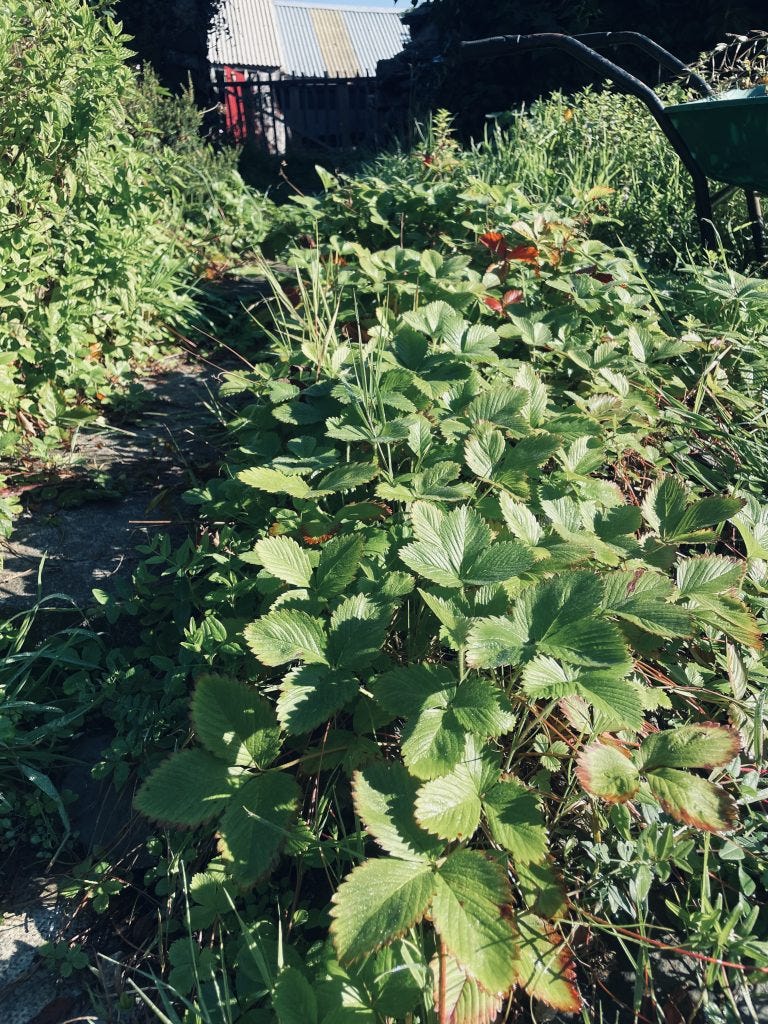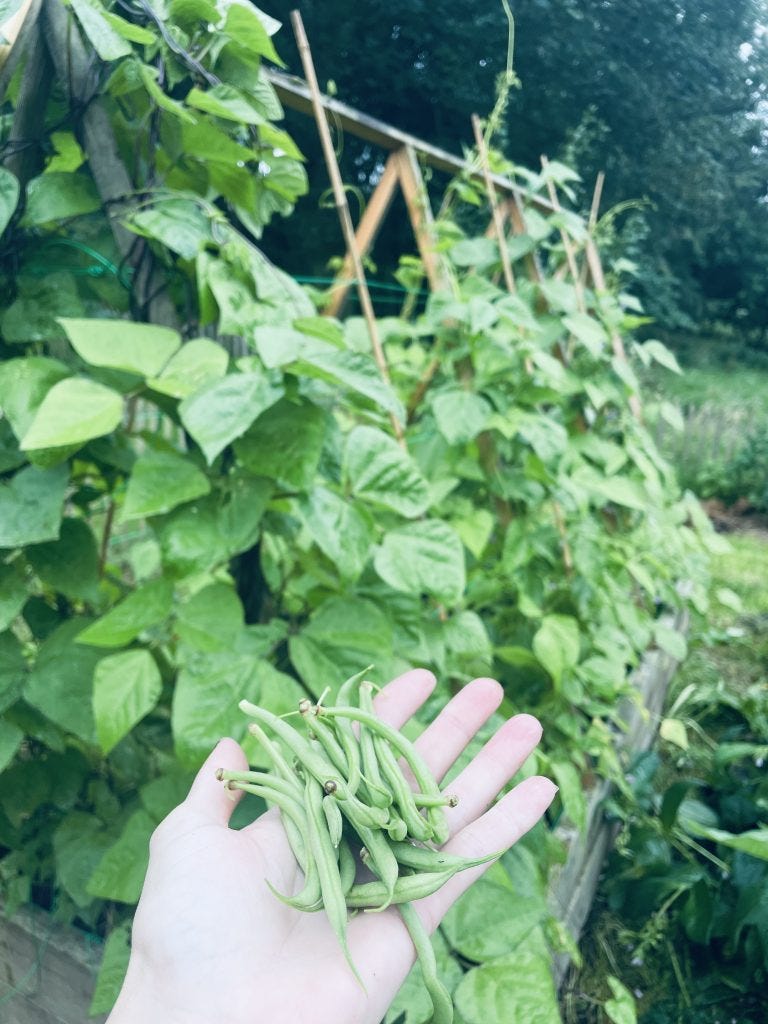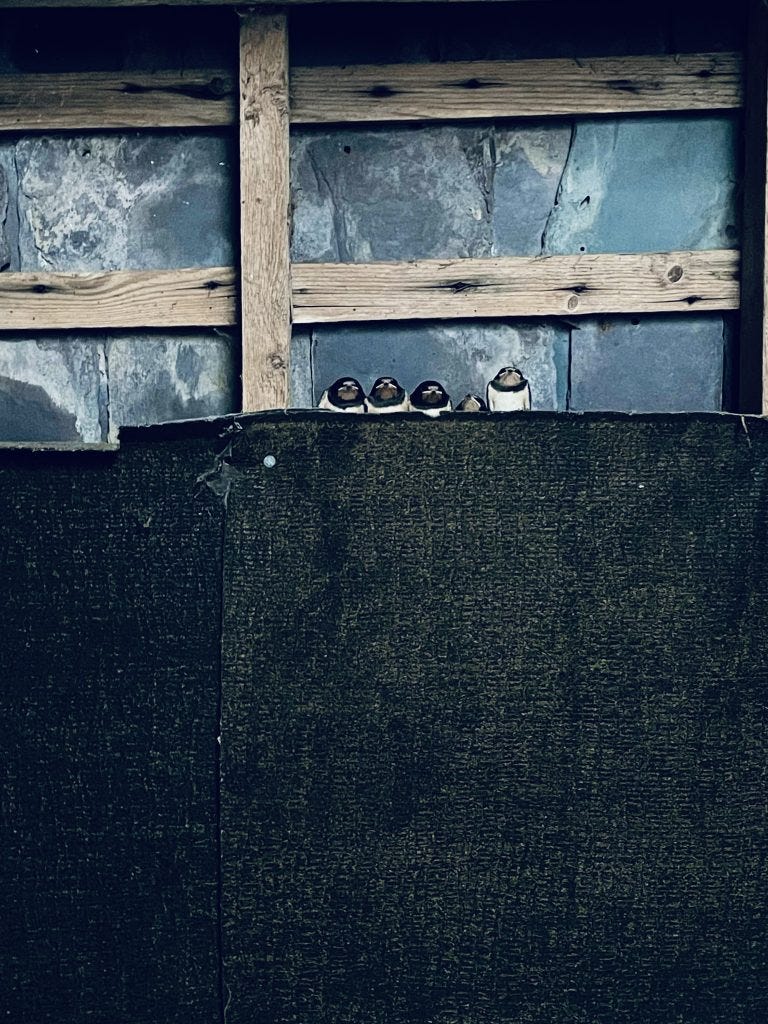Letters of Introduction
As I worked in the garden this month, I composed letters of introduction to our tenants. I began with knitbone (comfrey) because she is the most likely to be overlooked. Her broad leaves bristle with hairs, they are dock-like, plain. You might miss the little purple flowers entirely, if it were not for the hum of bees.
Dear tenants, I began, not only will comfrey heal your soil, but if you dry her leaves and infuse them in oil, she is medicine too. Knitbone is tethered to a part of the soil that most plants cannot access. Her thick, black tap root draws from a deeper well then stores the goodness in her leaves. Cut her to the ground and she will return; soak her leaves in water (if you can stomach the smell) and make a heady plant-brew; add her to the compost heap for a nutrient boost; praise the generosity of her flowers that refill with nectar every time a bee sips from their cup. That is knitbone, I hope you will work well together.
Uninvited Guests
Every bed I mulched last week brought another introduction to mind. Meet loganberry, grown by Mervyn the beekeeper, she needs some support. These are the strawberries that have kept us in jam for years. That rose is from my father, that one too and the one beside the front door. The chamomile is an uninvited guest but we extend generous hospitality to those who show up unannounced, especially when they bring clouds of insect companions.
The problem with this letter is that it is getting too long, and I do not want to leave anyone out. How would the fruit trees feel if I did not differentiate between the pruning needs of a damson and that of an espaliered pear? Or the perennial rocket – what a pity if she was mistaken for an annual and pulled out by the roots. And what of the flowers? The poppies will be fine, they are a bright rebellion against every planting scheme I have devised. The wisteria, sunflowers and thick clumps of Astrantia can fend for themselves. Beneath these hardy plants, however, there are bulbs, biding their time until spring. Should I introduce them too?
Once, when the weather was unbearably warm, we dug a pond in the middle of the vegetable garden. It was part of a long-term slug offensive that would bring frogs and eventually ducks to the garden. I wanted to redress the balance of predator and prey without the use of pesticides. The children and I dug in soil that was riddled with rocks. We prised boulders from the earth with crow bars and made a cairn with the rubble we raised. When the pond was finished, we planted water mint and creeping jenny and the small clump of yellow iris tripled in a year. The shards of slate upon which the names of these plants are written are buried among the bog plants and the pond is now a dark, mysterious centre in which dragonflies fizz.
The Meat
Which brings me to the meat of my introduction. You see, I keep biting my tongue to keep myself from apologising for the unkempt bunch I represent. Some of them are a little rough around the edges (next year is your year, artichoke, I promise) and one or two are a little forward. The alpine strawberries, for example. They came from a farmer’s market in Bantry; the seller had no shame charging 2Eur a plant for runners she dug out of the woodland. I tucked four small plants beside the path and now I can hardly walk into the garden without treading on an offshoot. Will our tenants accept these gregarious colonisers?
The apothecary garden is a riot. Huge drifts of lemon balm and ginger mint compete with hyssop, yarrow and calendula. These healing herbs do not behave like modern medicine but if handled with care, they bring comfort to the body. How can I convince another to let them rage and flourish in the flower bed?
Whispered Blessings
Our poultry shed operates on a deep mulch system – layers of fresh straw upon layers of soiled straw for the entire summer until it I clear it in the autumn to feed the vegetable beds. I tucked the plants in a little early this year, tipping wheelbarrow loads of rotted straw onto the soil and easing it around the flowers, the bean sprouts and the fruit trees. My whispered blessings fell with my tears as I prepared to leave yet another garden I have tended and loved.
‘Plumpness isn’t for you,” I tell the beans. “You like being lean, as if for the narrow path.” To the flowers I say, “You saved me,” and to the willow, “You taught me more about resilience than any book I ever read.”
‘To live in this world
you must be able
to do three things:
to love what is mortal;
to hold it
against your bones knowing
your own life depends on it;
and, when the time comes to let it
go,
to let it go.’
In Blackwater Woods, Mary Oliver
On Ethics
Our readaloud this week was, Unlocking the Universe. In it, Research Fellow from the University of Oxford, Carissa Veliz, discusses the ethics of AI and how the things we invent can impact the world. I asked the kids: how might you leave the world a better place? My eldest responded immediately that he would make music, my daughter took a moment to think and then said: ‘Every time we move house, we leave the garden more beautiful than when we arrived. Does that count?’
Yes.
I stood in the August rain and watched a kettle of swallows come to boil in the sky above my garden. There are more than last year, swooping low above the vegetable patch to feed on the wing. From this wild patch of land, I have fed my family, concocted healing salves and grown flowers for friends and family. I have provided forage for my bees and all their wilder cousins who have, in turn, pollinated my plants and those of my neighbours. More insects than I can mention have made their home here, raised their young and taken their place in the food chain. It is not tidy, there are no clean lines or neat edges, but it is beautiful.
Our Migration
The swallows are preparing to leave. Soon, the four chicks who were raised in my wash shed and who bed down in the roof felt every evening, will migrate south. At the same time, we will migrate west, and I will entrust my garden to our tenants. I will carry some of my garden with me: little pots of strawberry runners, self-sown lady's mantle, the seeds of calendula, poppy and borage and a sack of spring bulbs I dug up the day after we decided to move our family to Sligo.
I will not have a garden in our new house but I will have the wild woods and coastline of God's own country on my doorstep. The bees will come too. They know all about the hill on which we will live, the avenue of hazel that leads to the lake, the clumps of gorse and fields of clover. I cannot wait to taste that landscape.
In the meantime, this is how my letter of introduction will really read:
Dear Tenants, here is my garden, it is every bit as wild as it looks. I hope it will care for you the way it has cared for me. With love, Bethany
The rest they will learn as they go.







